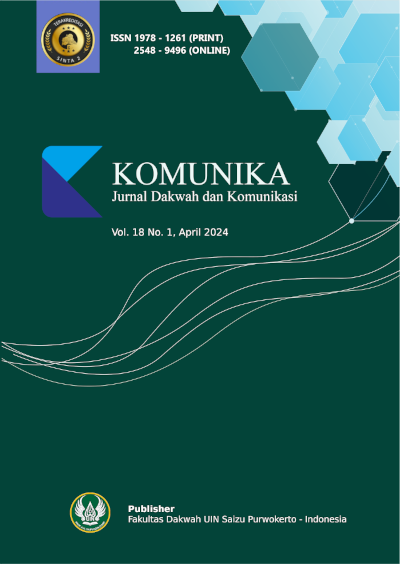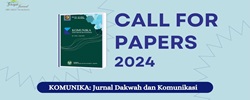Data Privacy Protection in Islamic Communication Perspective
DOI:
https://doi.org/10.24090/komunika.v18i1.7847Keywords:
Islamic communication, data protection, data privacy, Al-Qur'anAbstract
Technology development brings many conveniences, but on the other hand, it also provides challenges, such as data security. The phenomenon of hacking personal data that ends in fraud and other crimes seems to be evidence. Technology in the era of society 5.0 was rising to facilitate human work, but it is used to misuse big data from the individual level. Social media provides opportunities for open privacy by revealing confidential personal data. In addition to requiring self-control, it also requires security and data protection. This research aims to analyze the phenomenon of data theft in the context of Islamic communication with solutions obtained from the perspective of the Qur'an. The method utilized is qualitative research through literature study using a constructivist paradigm. The results of this study revealed that internal and external factors caused data theft. The ability to filter information and information literacy in the digital space, maintain ethics in the media space, integrate roles between government and society, and protect digital communication from the perspective of the Qur'an have a positive effect on information preservation in the digital realm. In addition, continuous integration between the government and the community is also needed to overcome the rife data theft problem.References
Al-Khater, W. A., Al-Maadeed, S., Ahmed, A. A., Sadiq, A. S., & Khan, M. K. (2020). Comprehensive review of cybercrime detection techniques. IEEE Access, 8, 137293–137311. https://doi.org/10.1109/ACCESS.2020.3011259
Al-Naisaburi, A. H. M. A. (2011). Kitab Shahih Muslim. Darul Hadis.
Anantama, A. (2022). Ancaman Data Pribadi di Era Digital Dalam Perspektif Islam. Ath-Thariq ; Jurnal Dakwah Dan Komunikasi, 06(02), 220–235.
Aswandi, R. dkk. (2018). Perlindungan Data dan Informasi Pribadi melalui Indonesian Data Protection System (IDPS). Jurnal Universitas Hasanuddin, 3(2), 63–65. https://doi.org/10.15900/j.cnki.zylf1995.2018.02.001
Ayu, I. W., Zulkarnaen, & Fitriyanto, S. (2022). Budaya Digital dalam Transformasi Digital Menghadapi Era Society 5.0. Jurnal Pengembangan Masyarakat Lokal, 5(1), 20–25.
Bestari, N. P. (2022). Usai Registrasi SIM Card, Data KPU Juga Dilaporkan Bocor?
Budhijanto, D. (2017). Revolusi Cyberlaw Indonesia. Revolusi Cyberlaw Indonesia.
Carl Pegels, C., & Thirumurthy, M. V. (1996). The impact of technology strategy on firm performance. IEEE Transactions on Engineering Management, 43(3), 246–249. https://doi.org/10.1109/17.511835
Creswell, J. W. (2003). Creswell, J.W. (2003). Chapter One, “A Framework for Design.” Research Design Qualitative Quantitative and Mixed Methods Approaches, 3–26. https://doi.org/10.3109/08941939.2012.723954
DESJARDINS, J. (2016). The Evolution of Instant Messaging. Online, May, 1. https://doi.org/10.13140/RG.2.2.22305.10085
Dihni, V. A. (2022). Kasus Kebocoran Data di Indonesia Melonjak 143% pada Kuartal II 2022.
Fad, M. F. (2021). Perlindungan Data Pribadi dalam Perspektif Sadd Dzari’ah. Jurnal Hukum Ekonomi Syariah, 13(1).
Fahlevi, M., Saparudin, M., Maemunah, S., Irma, D., & Ekhsan, M. (2019). Cybercrime Business Digital in Indonesia. E3S Web of Conferences, 125(201 9), 1–5. https://doi.org/10.1051/e3sconf/201912521001
Fikri, K. (2021). Privasi Dalam Dunia Digital ( Analisis Qs An-Nur (24): 27 Menggunakan Pendekatan Ma ’ Na -Cum-Maghza ). Islamika Inside: Jurnal Keislaman Dan Humaniora, 7(2), 198–222.
Filippi, P. De, & Mccarthy, S. (2012). Cloud Computing : Centralization and Data Sovereignty. European Journal of Law and Technology, 3(2), 1–18.
Gunawan, H. (2021). Pengukuran Kesadaran Keamanan Informasi Dan Privasi Dalam Sosial Media. Jurnal Muara Sains, Teknologi, Kedokteran Dan Ilmu Kesehatan, 5(1), 1. https://doi.org/10.24912/jmstkik.v5i1.3456
Hamka. (2018). Tafsir Al-Azhar. Gema Insani.
Kamilah, F. N. dan S. B. L. (2020). Manajemen Privasi pada Pengguna Media Sosial Instagram Ferisa. 21(1), 1–9.
Kementerian Agama RI. (2021). Al-Qur’an Terjemah. Kementerian Agama RI.
Kharisma Putra, I. K. O., Darmawan, I. M. A., Juliana, I. P. G., & Indriyani. (2023). Tindakan Kejahatan Pada Dunia Digital Dalam Bentuk Phising. Cyber Security Dan Forensik Digital, 5(2), 77–82. https://doi.org/10.14421/csecurity.2022.5.2.3797
Kirillova, E. A., Koval, V. N., Zenin, S., Parshin, N. M., & Shlyapnikova, O. V. (2021). Digital Right Protection Principles under Digitalization. Webology, 18(Special Issue), 910–930. https://doi.org/10.14704/WEB/V18SI04/WEB18173
Lathiya, Adik Nur, Benny Irawan, dan R. Y. (2021). Kebijakan Hukum Pidana Terhadap Pengaturan Pencurian Data Pribadi Sebagai Penyalahgunaan Teknologi Komunikasi Dan Informasi. Jurnal Hukum Pidana Dan Kriminologi, 2(2).
Lee, J. K., Chang, Y., Kwon, H. Y., & Kim, B. (2020). Reconciliation of Privacy with Preventive Cybersecurity: The Bright Internet Approach. Information Systems Frontiers, 22(1), 45–57. https://doi.org/10.1007/s10796-020-09984-5
Leukfeldt, E. R., & Holt, T. J. (2022). Cybercrime on the menu? Examining cafeteria-style offending among financially motivated cybercriminals. Computers in Human Behavior, 126(August 2021), 106979. https://doi.org/10.1016/j.chb.2021.106979
Lincoln, D. and. (2009). Handbook of Qualitative Research. Pustaka Pelajar.
Lintang, C. (2021). Tinjauan Hukum Pidana Islam terhadap Cybercrime dalam bentuk Pencurian Data Pribadi. UIN Sunan Ampel Surabaya.
Lubis, M., & Handayani, D. O. D. (2021). The relationship of personal data protection towards internet addiction: Cyber crimes, pornography and reduced physical activity. Procedia Computer Science, 197(2021), 151–161. https://doi.org/10.1016/j.procs.2021.12.129
Majelis Ulama Indonesia. (2017). Fatwa Majelis Ulama Indonesia (MUI) tentang Hukum dan Bermuamalah Melalui Media Sosial. Majelis Ulama Indonesia.
Mamduh, N. (2023). Indeks Literasi Digital Indonesia Naik Tipis, tapi Keamanan Digital Rendah.
Mohammed, A., Abed, H., & Hassoon, N. (2016). The Impact of Digital Communication on Social Networks: A Review. International Journal of Computer Science and Mobile Computing, 5(1), 183–190.
Monteith, S., Bauer, M., Alda, M., Geddes, J., Whybrow, P. C., & Glenn, T. (2021). Increasing Cybercrime Since the Pandemic: Concerns for Psychiatry. Current Psychiatry Reports, 23(4). https://doi.org/10.1007/s11920-021-01228-w
Muhammad, F., & Abdurrakhman, A. (2022). Urgensi Pengaturan Hukum Terhadap Pelaku Tindak Pidana Pencurian Data Pribadi di Indonesia. YUTISI Jurnal Hukum Dan Hukum Islam, 9(1), 1–13.
Nair, S. R. (2020). A review on ethical concerns in big data management. International Journal of Big Data Management, 1(1), 8. https://doi.org/10.1504/ijbdm.2020.106886
Neuman, W. (2003). W. Lawrence Neuman, Social Research Methods: Qualitative and Quantitative Approaches. January, 4–6.
Nugraha, Y., Kautsarina, & Sastrosubroto, A. S. (2015). Towards data sovereignty in cyberspace. 2015 3rd International Conference on Information and Communication Technology, ICoICT 2015, 2, 465–471. https://doi.org/10.1109/ICoICT.2015.7231469
Nurhidaya, A. A. (2020). Media Sosial dan Tantangan Masa Depan Generasi Milenial. Avant Garde: Jurnal Ilmu Komunikasi, 8(2).
Park, S. H. (2016). On the effectiveness of social media for the public relations of Korean government ministries. Indian Journal of Science and Technology, 9(46). https://doi.org/10.17485/ijst/2016/v9i46/107399
Patton, M. Q. (2002). Nontraditional Regulations, and Innovations in Darning-Centered, Doctoral Education, Including Faculty Meetings That Are Interesting and Important, an Indication of Knovation of the Highest Order. In Qualitative Inquiry.
Payne, B. K., & Hadzhidimova, L. (2020). Disciplinary and interdisciplinary trends in cybercrime research: An examination. International Journal of Cyber Criminology, 14(1), 81–105. https://doi.org/10.5281/zenodo.3741131
Pertiwi, W. K., & Wahyudi, R. (2021). Kronologi Kasus Kebocoran Data WNI, Dijual 0,15 Bitcoin hingga Pemanggilan Direksi BPJS. Kompas.Com. https://tekno.kompas.com/read/2021/05/22/09450057/kronologi-kasus-kebocoran-data-wni-dijual-0-15-bitcoin-hingga-pemanggilan?page=all
Petronio, S. (2002). Boundaries of privacy: Dialectics of disclosure. Suny Press.
Putri, V. M. (2023). Duh! Data 200 Juta Pengguna Twitter Bocor, Dijual Rp 30 Ribuan.
Raodia. (2019). Pengaruh Perkembangan Teknologi terhadap Terjadinya Kejahatan Mayantara (Cybercrime). Jurnal Jurisprudentie, 6(2).
Riva’i, M. (1983). Ushul Fiqih. PT. Al-Ma’arif.
Rumlus, M. H., & Hartadi, H. (2020). Kebijakan Penanggulangan Pencurian Data Pribadi dalam Media Elektronik. Jurnal HAM, 11(2), 285. https://doi.org/10.30641/ham.2020.11.285-299
rwestbr. (2013). Microsoft Word - Lotrionte galleysPROOFS2. 7(13), 1–95.
Saidah, M. (2021). Manajemen Privasi Komunikasi di Era TransparansiInformasi (Studi Pada Pelanggaran Privasi DalamHubungan Pertemanan). Jurnal INTERAKSI PERADABAN, 1(2), 193–217.
Schmidt, E. dan J. C. (2021). The New Digital Age. Gramedia.
Shihab, M. Q. (2016). Tafsir Al Misbah: Pesan, Kesan, dan Keserasian AlQur’an Volume 6. Lentera Hati.
Situmeang, S. M. T. (2021). Penyalahgunaan Data Pribadi sebagai Bentuk Kejahatan dalam Perspektif Hukum Siber. Jurnal SASI, 27(1).
Sufa, I. G. (2023). Hacker Pembuat Aplikasi Penipuan Undangan Nikah Berstatus Mahasiswa.
Sumadiria, H. (2018). Hukum dan Etika Media Massa. Remaja Rosdakarya.
Tim Pustaka Yustisia. (2018). UUD 1945 Amandemen Lengkap. PT. Buku Seru.
Tobing, N. K. L. (2021). Pengaruh Media Sosial Berbasis Web 4.0 Terhadap Manajemen Privasi Komunikasi. Jurnal Muara Ilmu Sosial, Humaniora, Dan Seni, 5(1), 92. https://doi.org/10.24912/jmishumsen.v5i1.8185.2021
Vebryto, R., & Irwansyah, I. (2020). Pencurian Data dan Informasi di Media Sosial Melalui Informasi Hoax: Studi Kasus pada Media Sosial Facebook. Perspektif, 9(2), 366–377. https://doi.org/10.31289/perspektif.v9i2.3627
Wattimena, S. (2023). Hati-hati Penipuan Berkedok Undangan Nikah Ramai Terjadi.
Wijaya, R., & Malikah, S. S. (2021). Interpretasi kata Sulthan (Kajian Ma’na Cum Maghza Terhadap Q.S. Ar-Rahman (55): 33). Al-Dzikra: Jurnal Studi Ilmu Al-Qur’an Dan Al-Hadits, 15(2), 239–258. https://doi.org/10.24042/al-dzikra.v15i2.9713
Yalina, N., & Kunaefi, A. (2017). Undang-Undang Informasi dan Transaksi Elektronik Dalam Perspektif IT Security, Privasi dan Etika Dalam Islam. Jurnal SNRT Poliban, 3(2), 99–117.
Yuliartini, N. P. R., & Pramita, K. D. (2022). Jurnal komunikasi hukum. Jurnal Komunikasi Hukum, 8(1), 469–480.
Al-Khater, W. A., Al-Maadeed, S., Ahmed, A. A., Sadiq, A. S., & Khan, M. K. (2020). Comprehensive review of cybercrime detection techniques. IEEE Access, 8, 137293–137311. https://doi.org/10.1109/ACCESS.2020.3011259
Al-Naisaburi, A. H. M. A. (2011). Kitab Shahih Muslim. Darul Hadis.
Anantama, A. (2022). Ancaman Data Pribadi di Era Digital Dalam Perspektif Islam. Ath-Thariq ; Jurnal Dakwah Dan Komunikasi, 06(02), 220–235.
Aswandi, R. dkk. (2018). Perlindungan Data dan Informasi Pribadi melalui Indonesian Data Protection System (IDPS). Jurnal Universitas Hasanuddin, 3(2), 63–65. https://doi.org/10.15900/j.cnki.zylf1995.2018.02.001
Ayu, I. W., Zulkarnaen, & Fitriyanto, S. (2022). Budaya Digital dalam Transformasi Digital Menghadapi Era Society 5.0. Jurnal Pengembangan Masyarakat Lokal, 5(1), 20–25.
Bestari, N. P. (2022). Usai Registrasi SIM Card, Data KPU Juga Dilaporkan Bocor?
Budhijanto, D. (2017). Revolusi Cyberlaw Indonesia. Revolusi Cyberlaw Indonesia.
Carl Pegels, C., & Thirumurthy, M. V. (1996). The impact of technology strategy on firm performance. IEEE Transactions on Engineering Management, 43(3), 246–249. https://doi.org/10.1109/17.511835
Creswell, J. W. (2003). Creswell, J.W. (2003). Chapter One, “A Framework for Design.” Research Design Qualitative Quantitative and Mixed Methods Approaches, 3–26. https://doi.org/10.3109/08941939.2012.723954
DESJARDINS, J. (2016). The Evolution of Instant Messaging. Online, May, 1. https://doi.org/10.13140/RG.2.2.22305.10085
Dihni, V. A. (2022). Kasus Kebocoran Data di Indonesia Melonjak 143% pada Kuartal II 2022.
Fad, M. F. (2021). Perlindungan Data Pribadi dalam Perspektif Sadd Dzari’ah. Jurnal Hukum Ekonomi Syariah, 13(1).
Fahlevi, M., Saparudin, M., Maemunah, S., Irma, D., & Ekhsan, M. (2019). Cybercrime Business Digital in Indonesia. E3S Web of Conferences, 125(201 9), 1–5. https://doi.org/10.1051/e3sconf/201912521001
Fikri, K. (2021). Privasi Dalam Dunia Digital ( Analisis Qs An-Nur (24): 27 Menggunakan Pendekatan Ma ’ Na -Cum-Maghza ). Islamika Inside: Jurnal Keislaman Dan Humaniora, 7(2), 198–222.
Filippi, P. De, & Mccarthy, S. (2012). Cloud Computing : Centralization and Data Sovereignty. European Journal of Law and Technology, 3(2), 1–18.
Gunawan, H. (2021). Pengukuran Kesadaran Keamanan Informasi Dan Privasi Dalam Sosial Media. Jurnal Muara Sains, Teknologi, Kedokteran Dan Ilmu Kesehatan, 5(1), 1. https://doi.org/10.24912/jmstkik.v5i1.3456
Hamka. (2018). Tafsir Al-Azhar. Gema Insani.
Kamilah, F. N. dan S. B. L. (2020). Manajemen Privasi pada Pengguna Media Sosial Instagram Ferisa. 21(1), 1–9.
Kementerian Agama RI. (2021). Al-Qur’an Terjemah. Kementerian Agama RI.
Kharisma Putra, I. K. O., Darmawan, I. M. A., Juliana, I. P. G., & Indriyani. (2023). Tindakan Kejahatan Pada Dunia Digital Dalam Bentuk Phising. Cyber Security Dan Forensik Digital, 5(2), 77–82. https://doi.org/10.14421/csecurity.2022.5.2.3797
Kirillova, E. A., Koval, V. N., Zenin, S., Parshin, N. M., & Shlyapnikova, O. V. (2021). Digital Right Protection Principles under Digitalization. Webology, 18(Special Issue), 910–930. https://doi.org/10.14704/WEB/V18SI04/WEB18173
Lathiya, Adik Nur, Benny Irawan, dan R. Y. (2021). Kebijakan Hukum Pidana Terhadap Pengaturan Pencurian Data Pribadi Sebagai Penyalahgunaan Teknologi Komunikasi Dan Informasi. Jurnal Hukum Pidana Dan Kriminologi, 2(2).
Lee, J. K., Chang, Y., Kwon, H. Y., & Kim, B. (2020). Reconciliation of Privacy with Preventive Cybersecurity: The Bright Internet Approach. Information Systems Frontiers, 22(1), 45–57. https://doi.org/10.1007/s10796-020-09984-5
Leukfeldt, E. R., & Holt, T. J. (2022). Cybercrime on the menu? Examining cafeteria-style offending among financially motivated cybercriminals. Computers in Human Behavior, 126(August 2021), 106979. https://doi.org/10.1016/j.chb.2021.106979
Lincoln, D. and. (2009). Handbook of Qualitative Research. Pustaka Pelajar.
Lintang, C. (2021). Tinjauan Hukum Pidana Islam terhadap Cybercrime dalam bentuk Pencurian Data Pribadi. UIN Sunan Ampel Surabaya.
Lubis, M., & Handayani, D. O. D. (2021). The relationship of personal data protection towards internet addiction: Cyber crimes, pornography and reduced physical activity. Procedia Computer Science, 197(2021), 151–161. https://doi.org/10.1016/j.procs.2021.12.129
Majelis Ulama Indonesia. (2017). Fatwa Majelis Ulama Indonesia (MUI) tentang Hukum dan Bermuamalah Melalui Media Sosial. Majelis Ulama Indonesia.
Mamduh, N. (2023). Indeks Literasi Digital Indonesia Naik Tipis, tapi Keamanan Digital Rendah.
Mohammed, A., Abed, H., & Hassoon, N. (2016). The Impact of Digital Communication on Social Networks: A Review. International Journal of Computer Science and Mobile Computing, 5(1), 183–190.
Monteith, S., Bauer, M., Alda, M., Geddes, J., Whybrow, P. C., & Glenn, T. (2021). Increasing Cybercrime Since the Pandemic: Concerns for Psychiatry. Current Psychiatry Reports, 23(4). https://doi.org/10.1007/s11920-021-01228-w
Muhammad, F., & Abdurrakhman, A. (2022). Urgensi Pengaturan Hukum Terhadap Pelaku Tindak Pidana Pencurian Data Pribadi di Indonesia. YUTISI Jurnal Hukum Dan Hukum Islam, 9(1), 1–13.
Nair, S. R. (2020). A review on ethical concerns in big data management. International Journal of Big Data Management, 1(1), 8. https://doi.org/10.1504/ijbdm.2020.106886
Neuman, W. (2003). W. Lawrence Neuman, Social Research Methods: Qualitative and Quantitative Approaches. January, 4–6.
Nugraha, Y., Kautsarina, & Sastrosubroto, A. S. (2015). Towards data sovereignty in cyberspace. 2015 3rd International Conference on Information and Communication Technology, ICoICT 2015, 2, 465–471. https://doi.org/10.1109/ICoICT.2015.7231469
Nurhidaya, A. A. (2020). Media Sosial dan Tantangan Masa Depan Generasi Milenial. Avant Garde: Jurnal Ilmu Komunikasi, 8(2).
Park, S. H. (2016). On the effectiveness of social media for the public relations of Korean government ministries. Indian Journal of Science and Technology, 9(46). https://doi.org/10.17485/ijst/2016/v9i46/107399
Patton, M. Q. (2002). Nontraditional Regulations, and Innovations in Darning-Centered, Doctoral Education, Including Faculty Meetings That Are Interesting and Important, an Indication of Knovation of the Highest Order. In Qualitative Inquiry.
Payne, B. K., & Hadzhidimova, L. (2020). Disciplinary and interdisciplinary trends in cybercrime research: An examination. International Journal of Cyber Criminology, 14(1), 81–105. https://doi.org/10.5281/zenodo.3741131
Pertiwi, W. K., & Wahyudi, R. (2021). Kronologi Kasus Kebocoran Data WNI, Dijual 0,15 Bitcoin hingga Pemanggilan Direksi BPJS. Kompas.Com. https://tekno.kompas.com/read/2021/05/22/09450057/kronologi-kasus-kebocoran-data-wni-dijual-0-15-bitcoin-hingga-pemanggilan?page=all
Petronio, S. (2002). Boundaries of privacy: Dialectics of disclosure. Suny Press.
Putri, V. M. (2023). Duh! Data 200 Juta Pengguna Twitter Bocor, Dijual Rp 30 Ribuan.
Raodia. (2019). Pengaruh Perkembangan Teknologi terhadap Terjadinya Kejahatan Mayantara (Cybercrime). Jurnal Jurisprudentie, 6(2).
Riva’i, M. (1983). Ushul Fiqih. PT. Al-Ma’arif.
Rumlus, M. H., & Hartadi, H. (2020). Kebijakan Penanggulangan Pencurian Data Pribadi dalam Media Elektronik. Jurnal HAM, 11(2), 285. https://doi.org/10.30641/ham.2020.11.285-299
rwestbr. (2013). Microsoft Word - Lotrionte galleysPROOFS2. 7(13), 1–95.
Saidah, M. (2021). Manajemen Privasi Komunikasi di Era TransparansiInformasi (Studi Pada Pelanggaran Privasi DalamHubungan Pertemanan). Jurnal INTERAKSI PERADABAN, 1(2), 193–217.
Schmidt, E. dan J. C. (2021). The New Digital Age. Gramedia.
Shihab, M. Q. (2016). Tafsir Al Misbah: Pesan, Kesan, dan Keserasian AlQur’an Volume 6. Lentera Hati.
Situmeang, S. M. T. (2021). Penyalahgunaan Data Pribadi sebagai Bentuk Kejahatan dalam Perspektif Hukum Siber. Jurnal SASI, 27(1).
Sufa, I. G. (2023). Hacker Pembuat Aplikasi Penipuan Undangan Nikah Berstatus Mahasiswa.
Sumadiria, H. (2018). Hukum dan Etika Media Massa. Remaja Rosdakarya.
Tim Pustaka Yustisia. (2018). UUD 1945 Amandemen Lengkap. PT. Buku Seru.
Tobing, N. K. L. (2021). Pengaruh Media Sosial Berbasis Web 4.0 Terhadap Manajemen Privasi Komunikasi. Jurnal Muara Ilmu Sosial, Humaniora, Dan Seni, 5(1), 92. https://doi.org/10.24912/jmishumsen.v5i1.8185.2021
Vebryto, R., & Irwansyah, I. (2020). Pencurian Data dan Informasi di Media Sosial Melalui Informasi Hoax: Studi Kasus pada Media Sosial Facebook. Perspektif, 9(2), 366–377. https://doi.org/10.31289/perspektif.v9i2.3627
Wattimena, S. (2023). Hati-hati Penipuan Berkedok Undangan Nikah Ramai Terjadi.
Wijaya, R., & Malikah, S. S. (2021). Interpretasi kata Sulthan (Kajian Ma’na Cum Maghza Terhadap Q.S. Ar-Rahman (55): 33). Al-Dzikra: Jurnal Studi Ilmu Al-Qur’an Dan Al-Hadits, 15(2), 239–258. https://doi.org/10.24042/al-dzikra.v15i2.9713
Yalina, N., & Kunaefi, A. (2017). Undang-Undang Informasi dan Transaksi Elektronik Dalam Perspektif IT Security, Privasi dan Etika Dalam Islam. Jurnal SNRT Poliban, 3(2), 99–117.
Yuliartini, N. P. R., & Pramita, K. D. (2022). Jurnal komunikasi hukum. Jurnal Komunikasi Hukum, 8(1), 469–480.
Downloads
Published
How to Cite
Issue
Section
License
Copyright (c) 2024 Musfiah Saidah, Hilya Maylaffayza

This work is licensed under a Creative Commons Attribution-ShareAlike 4.0 International License.
Authors who publish with this journal agree to the following terms:
- Authors retain copyright and grant the journal right of first publication with the work simultaneously licensed under a Creative Commons Attribution-ShareAlike 4.0 International License that allows others to share the work with an acknowledgement of the work's authorship and initial publication in this journal.
- Authors are able to enter into separate, additional contractual arrangements for the non-exclusive distribution of the journal's published version of the work (e.g., post it to an institutional repository or publish it in a book), with an acknowledgement of its initial publication in this journal.
- Authors are permitted and encouraged to post their work online (e.g., in institutional repositories or on their website) prior to and during the submission process, as it can lead to productive exchanges, as well as earlier and greater citation of published work (See The Effect of Open Access).





















